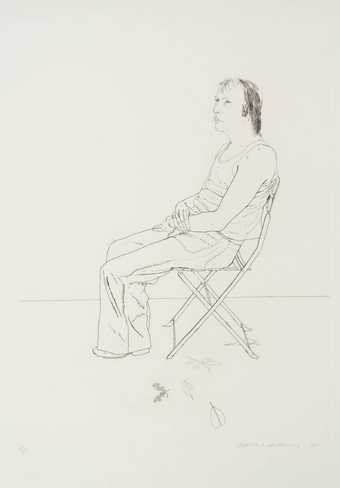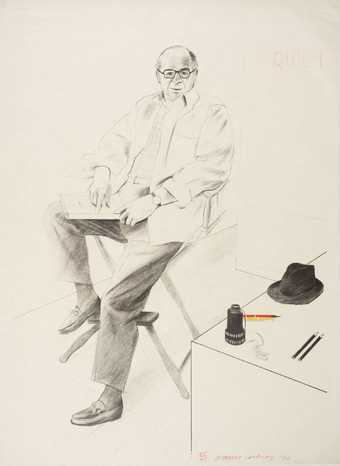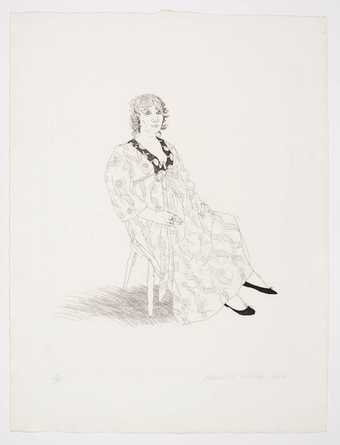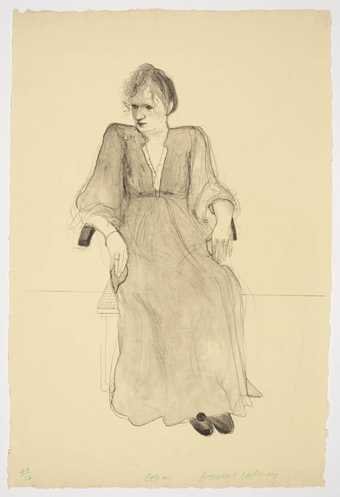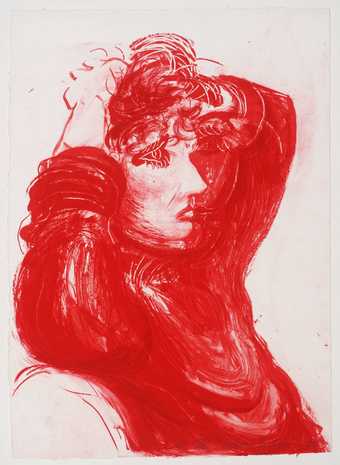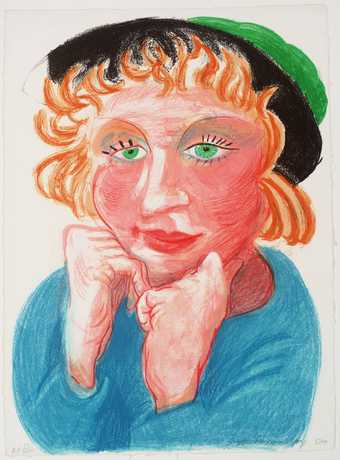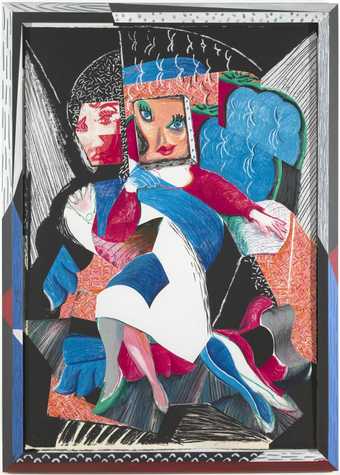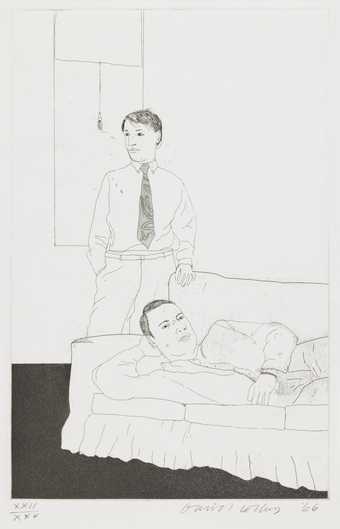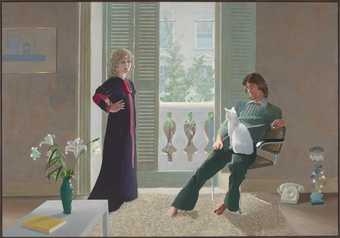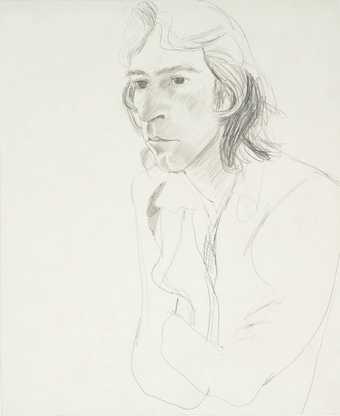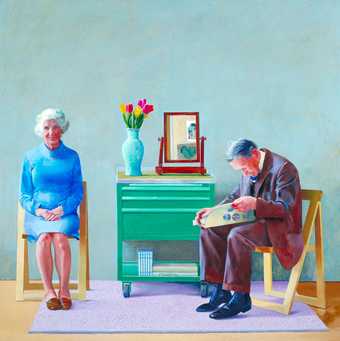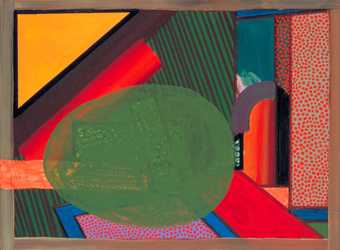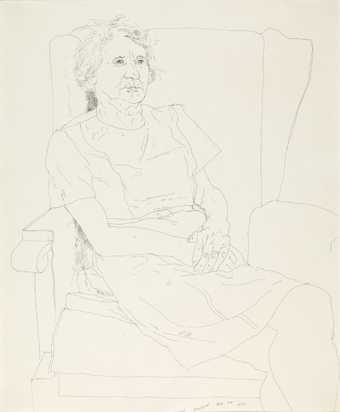
On loan
Musée Granet (Aix-en-Provence, France): David Hockney
- Artist
- David Hockney born 1937
- Medium
- Coloured pencil on paper
- Dimensions
- Support: 355 × 430 mm
- Collection
- Tate
- Acquisition
- Presented by the artist 1972
- Reference
- T01517
Summary
This is one of numerous studies Hockney made for his double portrait Mr and Mrs Clark and Percy, 1970-1 (Tate Gallery T01269). The husband and wife fashion designers Ossie Clark and Celia Birtwell were at the top of the fashion industry in London in the 'Swinging Sixties', when London's reputation as the fashion capital of the world was at its height. Clark designed clothes using Birtwell's textile designs, and sold them from the shop Quorum in Chelsea's King's Road.
The picture posed great technical problems for Hockney. It took him nearly a year to complete the painting: 'I kept taking photographs, making drawings, trying to work out a composition; for these big paintings I worked out the composition before I began, although I didn't draw them out totally. They're often drawn with a brush.' (Stangos, p.203.) This squared-up study shows the couple placed before slightly shuttered full-length windows. The figure of Ossie Clark had formerly been larger in proportion and the head set upright. The artist superimposed a sheet of paper over the figure and redrew it.
Hockney wrote, 'it's odd that Ossie is sitting down; it should really be the lady who's sitting down, but Celia's standing up. That alone causes a slight disturbance' (Stangos, p.204). He said that he did not suggest the reversed pose but that it was the way the couple naturally placed themselves. Birtwell's pose is more relaxed than in the finished painting. Although in the same position as in the painting, she hides much of the shutter behind her. Clark sits up straight across the side of the chair, one arm on his hip, the other flung over the back of the chair. He wears a light flowered shirt, which contrasts with the dark tones of Birtwell's dress. In the painting he wears a sweater over the shirt. The relaxed poses of the two figures are reversed for the painting. Birtwell takes on an almost columnar pose, Clark slouches in an armed chair, a white cat in his lap.
Shortly after its completion in 1971, the finished portrait was displayed at the National Portrait Gallery, London, together with all the preparatory drawings and photographs. The Tate owns two other studies for the painting (Tate Gallery T01515-16).
Further
reading:
Nikos Stangos (ed.), David Hockney by David Hockney, London 1976, pp.23, 197, 203-4, 239Marco Livingstone, David Hockney, revised edition, London 1987, pp.131, 136-7, 159
Terry Riggs
December 1997
Does this text contain inaccurate information or language that you feel we should improve or change? We would like to hear from you.
Catalogue entry
David Hockney b. 1937
T01517 Study for ‘Mr and Mrs Clark and Percy’ 1970
Not inscribed.
Coloured pencil, 10¿ x 15¿ (27 x 39.7) on paper 14 x 16 15/16 (35.5 x 43).
Presented by the artist 1972.
Exh: see T01515.
T01517 is a squared-up study of Celia Birtwell and Ossie Clark placed before slightly shuttered full-length windows. The figure of Ossie Clark had formerly been larger in proportion and the head set upright. The artist superimposed a sheet of paper 67 x 7¿ (24.8 x 20) over the figure and redrew it.
Celia Birtwell, although in the same position as in the painting, is more relaxed and she hides much of the shutter behind her. Ossie Clark’s chair is placed on a plane parallel to the picture plane. Clark sits up straight across the side of the chair, one arm on his hip, the other flung over the back of the chair. He wears a light flowered shirt, which casts an area of light about his face and contrasts with the dark tones of his wife’s dress. In the painting he wears a sweater over the shirt.
The relaxed poses of the two figures are reversed for the painting. Celia Birtwell takes on an almost columnar pose, Ossie Clark slouches in an armed chair, a white cat in his lap.
Published in The Tate Gallery Report 1970–1972, London 1972.
Explore
- interiors(2,776)
-
- domestic(1,795)
-
- living room(292)
- furnishings(3,081)
-
- shutter(14)
- Birtwell, Celia(8)
- Clark, Ossie(3)
- individuals: female(1,698)
- individuals: male(1,841)
- industrial and crafts(1,327)
-
- designer(300)
You might like
-
David Hockney Mo with Five Leaves
1971 -
David Hockney Billy Wilder
1976 -
David Hockney Celia
1969 -
David Hockney Celia
1973 -
David Hockney Red Celia
1984 -
David Hockney Celia with Green Hat
1984 -
David Hockney An Image of Celia
1984–6 -
David Hockney In Despair
1966 -
David Hockney Beautiful and White Flowers
1966 -
David Hockney Mr and Mrs Clark and Percy
1970–1 -
David Hockney Study for ‘Mr and Mrs Clark and Percy’
1970 -
David Hockney My Parents
1977 -
Howard Hodgkin Mr and Mrs E.J.P.
1969–73 -
David Hockney Bob, London
1964 -
David Hockney Portrait of the Artist’s Mother, Mrs Laura Hockney, Bradford
1972

